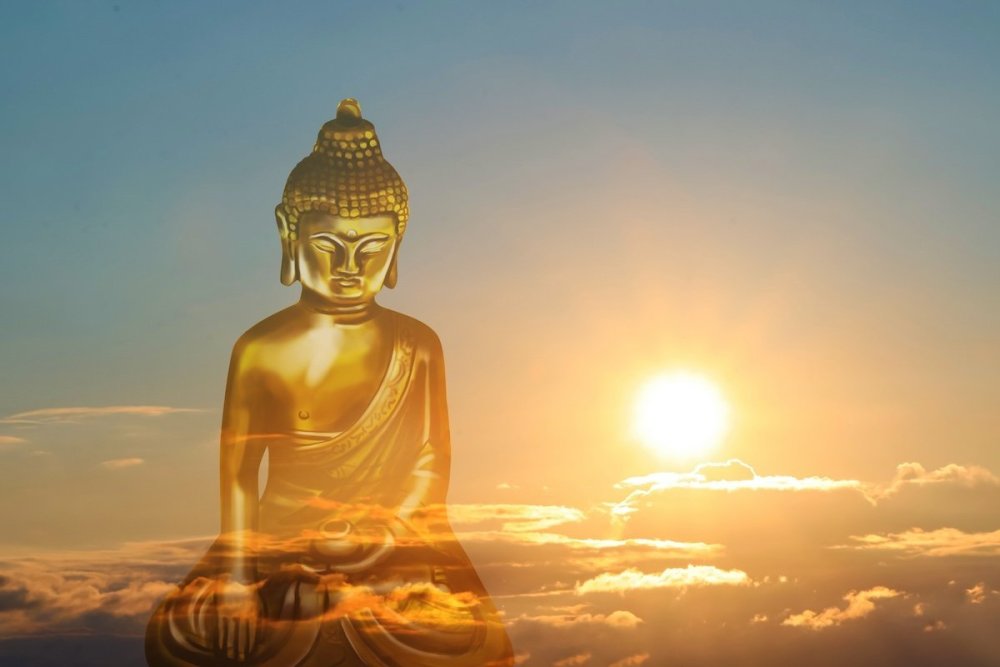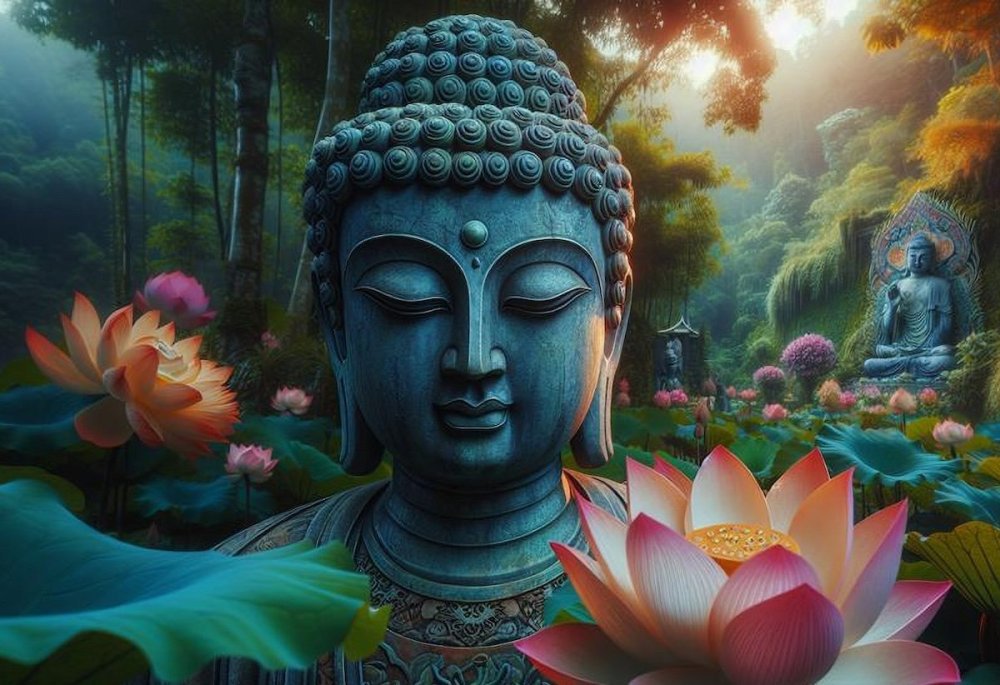Buddhism is a religion based on the Buddha's teachings. Ann Vrlak explains how beginners can learn how to practice Buddhism by following the concepts and practices in the Buddha’s roadmap, such as The Four Noble Truths and the Eightfold Path.
Is meditation a Buddhist practice? Many people think so, and in fact, that it best describes “what Buddhists do.”
But, if you have ever actually wondered how to become a Buddhist, there is so much more to it than mindfulness meditation! This worldwide religion, founded by the Buddha over 2,500 years ago, is a comprehensive system of values, practices and beliefs that offers a roadmap to create a happy and healthy life.
What is Buddhism?
Like Christianity, Buddhism began with one extraordinary person who was deeply troubled by the suffering and injustice of many people’s lives. He immersed himself in the religious beliefs of the day, hoping to understand and help alleviate human suffering.
RELATED: How Did Buddhism Spread?
The teachings that emerged from the Buddha’s transformation are both a religion and a philosophy, based on the core belief that everyone has the capacity to awaken.

Beginners can practice Buddhism by following its philosophy and ethics
Even though our lives would be almost unrecognisable to people from Buddha's time, our inner lives are not so different. People in all places and times worry about those they care about, feel hunger and loneliness, and have conflicts with others.
Becoming a Buddhist means being interested in these eternal questions: why do we suffer and is there a way to end it?
How to Practice Buddhism
As well as there being different branches or types of Buddhism, there are many ways to get into it – through its philosophy, ethics or practices. The best place to begin is to ask yourself: “Why am I interested in becoming a Buddhist?”
Are feelings of depression or anxiety becoming all too common for you? Do you want to start a meditation practice? Would you like to be more compassionate with your friends and family?
“The ultimate goal of practicing Buddhism is to break free from the cycle of samsara and reach nirvana.”
Whatever your answer is right now, Buddhism is a great place to begin because it shows you how to use your personal situations and experiences to deepen the connection with your own inner wisdom.
The Buddha’s System
The Buddha’s roadmap combines a deep understanding of human psychology with our spiritual aspirations. The following concepts and practices build on each other in ways that strengthen balance and ease.
1. The Four Noble Truths
The foundation of practicing Buddhism is the Four Noble Truths:
- Human life inevitably involves suffering or dukkha (“unsatisfactoriness”)
- This suffering is caused by the desire for something that is not present and by resistance to what is present
- The end of desire is the end of suffering through accepting the reality of the present
- The way to end desire is to follow the Eightfold Path
2. Eightfold Path
The Buddha’s Eightfold Path answers the question of exactly how to practice Buddhism. “But what does this look like in my everyday situations and challenges? What do I do?”
You can begin to change your thoughts and actions by practicing: Right View, Right Intention, Right Speech, Right Action, Right Livelihood, Right Effort, Right Mindfulness and Right Concentration.

Meditation is a key component of practicing Buddhism
Practicing Right View, for example, means seeing your anxiety about a health diagnosis through an understanding of the Four Noble Truths. Right Speech means striving to communicate with compassion, rather than irritation, and not gossiping about others or telling lies.
3. The Five Precepts
Along with encouraging actions that support your path, Buddhism suggests actions to avoid – you strengthen behaviours that lead to wisdom and weaken those that lead to suffering.
The Five Precepts help practitioners along the way by avoiding:
- doing harm
- stealing
- sexual misconduct
- harsh speech
- intoxication
4. Karma and Samsara
The Buddhists tie together the long view of practicing Buddhism with concepts of karma and samsara: how our actions shape our lives – both in this life and in the cycle of birth, death and rebirth, known as “samsara.”
“Along with philosophy and guidelines for action, meditation is one of the foundational tools for practicing Buddhism.”
Karma explains that what we put into the world, good and bad, returns to us in kind. Harmful actions create suffering and keep us bound in samsara. The ultimate goal of practicing Buddhism is to break free from the cycle of samsara and reach nirvana.
Karma: our actions shape our lives
How to Practice Buddhism with Meditation
Along with philosophy and guidelines for action, meditation is one of the foundational tools for practicing Buddhism. Many different forms of Buddhist meditation have flourished, with most falling into these three types of practice:
- Mindfulness Meditation
Mindfulness meditation is the key way of practicing Buddhism. You learn to observe your experience with some objectivity. “What thoughts am I having and how are they affecting me?” “What emotions are here when I’m arguing with my spouse?”
Becoming a Buddhist starts with this kind of curious, non-judgemental self-awareness.
- Lovingkindness Meditation
The practice of kindness and compassion is essential to help us be with the realities of day-to-day human suffering. Lovingkindness meditation teaches you to notice criticism of yourself or others, and instead choose warmth and acceptance.
- Concentration
Awareness and attention are considered superpowers in Buddhism. Your experience of life and your ability to act wisely depend on being able to put your attention where you want it – and to keep it there in spite of distractions or discomfort. Meditation for focus can help you with that. For example, you can learn to focus on your breath to calm your anger. You can also learn to turn your heart inward and practice self-compassion if you're lost in self-blame.
Learn More About Becoming a Buddhist
There are many (many!) places to learn how to practice Buddhism.
You can explore some of our best meditation book recommendations by Buddhist teachers. If you’re interested in how Buddhist practices affect your brain, Buddha’s Brain by psychologist Rick Hanson is a fascinating read!
“Becoming a Buddhist means being interested in these eternal questions: why do we suffer and is there a way to end it?”
Many meditation apps like Headspace and Calm incorporate Buddhist principles and practices. A relatively new offering, Healthy Minds, is a comprehensive, free app that blends Buddhist principles and practices with neuroscience.
RELATED: Do Buddhists Believe in God?
If you like podcasts, check out the huge libraries at The Secular Buddhism Podcast or Audio Dharma for content by monks, teachers and psychologists.
How to get into Buddhism: further steps
If you want to learn more about Buddhism, you may consider joining one of the many Buddhist communities – online or in person – or even pursuing living as a monk for a period of time.
A spiritual community, or sangha, is one of the most powerful ways to integrate practicing Buddhism into everyday life while having the support of others. Many established Buddhist centres offer short term retreats as a place to begin your exploration.

Nirvana is the ultimate aim of practicing Buddhism
These centres can also guide you if you want to take the plunge into a monastic life. Two of the most reputable monasteries worldwide are based on the teachings of Ajahn Chah and Thích Nhất Hạnh (Plum Village).
Takeaway: how to practice Buddhism
The ancient practice of Buddhism is no less relevant today in our modern world. In fact, many modern psychologists are Buddhists or use Buddhist approaches to reducing anxiety, fostering self-compassion and building stronger connections with people we care about. You can start small with a 15-minute daily meditation, listen to a podcast or dive in with a weekend retreat.
Remember that Buddhism starts with self-knowledge. Becoming a Buddhist involves you staying in the driver’s seat from the beginning, choosing where you want to go and which practices suit your interest best. ●
Images: shutterstock/New Africa, shutterstock/Cyril Hou, shutterstock/Semachkovsky, shutterstock AI generator
happiness.com | The fine art of being: learn, practise, share
Are you a happiness.com member? Sign up for free now to:
■ enjoy our happiness magazine with practical life tips
■ share and support others in our happiness forum
Dalai Lama | Acceptance | Altruism | Spirituality
Written by Ann Vrlak
 Ann Vrlak is Founder of OneSelf Meditation and a meditation practitioner for over 25 years. She’s a Certified Meditation Teacher for adults and for children (the best job ever!). She loves to share how the perspective and practice of meditation can support people with their everyday stresses and on their journey of self-discovery.
Ann Vrlak is Founder of OneSelf Meditation and a meditation practitioner for over 25 years. She’s a Certified Meditation Teacher for adults and for children (the best job ever!). She loves to share how the perspective and practice of meditation can support people with their everyday stresses and on their journey of self-discovery.



Join the conversation
You are posting as a guest. If you have an account, sign in now to post with your account.
There are no comments to display.